College Algebra
Answer/Discussion to PracticeProblems
on Radical Equations and
Equations Involving RationalExponents
 Answer/Discussionto 1a Answer/Discussionto 1a
|
| Step 1: Isolateone of the radicals. |
 |
*Inverse of add. 4 is sub. 4*Square root is by itself on one side of eq. |
| Step 2: Getrid of your radical sign. |
| If you square a square root, it will disappear. This is whatwe want to do here so that we can get x outfrom under the square root and continue to solve for it. |
 | *Inverse of taking the sq. root is squaringit |
| Step 3: If youstill have a radical left, repeat steps 1 and 2. |
| No more radicals exist, so we do not have to repeat steps 1 and 2. |
| Step 4: Solvethe remaining equation. |
| In this example the equation that resulted from squaring both sidesturned out to be a linear equation. If you need a review on solving linear equations, feel free to . |
 |
*Inverse of sub. 10 is add. 10
| | |
| Step 5: Checkfor extraneous solutions. |
| Lets check to see if x = 26 is an extraneoussolution: |
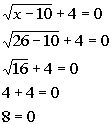 |
*Plugging in 26 for x
*False statement |
| Since we got a false statement, x =26 is an extraneous solution. There is no solution to this radical equation. |
 Answer/Discussionto 1b Answer/Discussionto 1b
|
| Step 1: Isolateone of the radicals. |
| The radical in this equation is already isolated. |
| Step 2: Getrid of your radical sign. |
| If you square a square root, it will disappear. This is whatwe want to do here so that we can get y outfrom under the square root and continue to solve for it. |
 | *Inverse of taking the sq. root is squaringit *Right side is a binomialsquared |
| Be careful on this one. Itis VERY TEMPTING to square the right side term by term and get 4+ (x + 1). However, you need to squareit as a side as shown above. Recall that when you square a binomialyou get the first term squared minus twice the product of the two termsplus the second term squared. If you need a review on squaring abinomial, feel free to . |
| Step 3: If youstill have a radical left, repeat steps 1 and 2. |
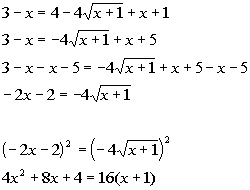 |
*Inverse of add. xand 5 is sub. x and 5
*Square root is by itself on one side of eq.
*Inverse of taking the sq. root is squaringit
*Left side is a binomialsquared
|
| Be careful on this one. Itis VERY TEMPTING to square the left side term by term and get 4xsquaredplus 4. However, you need to square it as a side as shown above. Recall that when you square a binomial you get the first term squared plustwice the product of the two terms plus the second term squared. If you need a review on squaring a binomial, feel free to . |
| Step 4: Solvethe remaining equation. |
| In this example the equation that resulted from squaring both sidesturned out to be a quadratic equation. If you need a review on solving quadratic equations feel free to |
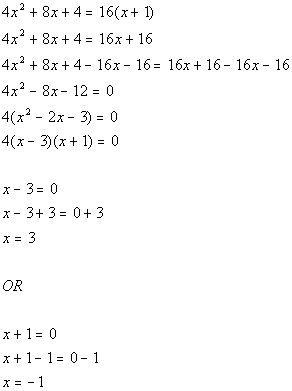 |
*Quad. eq. in standard form
*
*Set 1st factor = 0 and solve
*Set 2nd factor = 0 and solve
|
| Step 5: Checkfor extraneous solutions. |
| Lets check to see if x = 3 isan extraneous solution: |
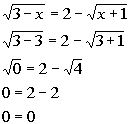 |
*Plugging in 3 for x
*True statement |
| Since we got a true statement, x = 3is a solution. |
| Lets check to see if x = -1 is an extraneoussolution: |
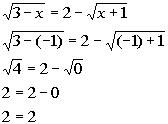 |
*Plugging in -1 for x
*True statement |
| Since we got a true statement, x = -1is a solution. There are two solutions to this radical equation: x= 3 and x = -1. |
 Answer/Discussionto 2a Answer/Discussionto 2a
|
| Step 1: Isolatethe base with the rational exponent. |
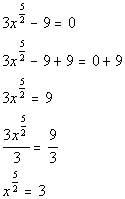 | *Inverse of sub. 9 is add. 9
*Inverse of mult. by 3 is div. by 3
*rat. exp. expression is by itself on one sideof eq. |
| Step 2: Getrid of the rational exponent. |
| If you raise an expression that has a rational exponent to the reciprocalof that rational exponent, the exponent will disappear. Thisis what we want to do here so that we can get xout from under the rational exponent and continue to solve for it. |
 |
*Inverse of taking it to the 5/2 poweris
taking it to the 2/5 power |
| Step 3: Solvethe remaining equation. |
| In this example the equation that resulted from raising both sidesto the 2/5 power turned out to be a linear equation. Also note that it is already solved for x. So we do not have to do anything on this step for this example. |
| Step 4: Checkfor extraneous solutions. |
Lets check to see if  is an extraneous solution: is an extraneous solution: |
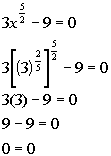 |
*Plugging in 3 to the 2/5 power for x
*True statement |
Since we got a true statement,  isa solution. isa solution.There is one solution to this rational exponent equation:  . . |
 Answer/Discussionto 2b Answer/Discussionto 2b
|
| Step 1: Isolatethe base with the rational exponent. |
| The base with the rational exponent is already isolated. |
| Step 2: Getrid of the rational exponent. |
| If you raise an expression that has a rational exponent to the reciprocalof that rational exponent, the exponent will disappear. Thisis what we want to do here so that we can get xout from under the rational exponent and continue to solve for it. |
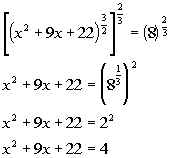 |
*Inverse of taking it to the 3/2 power is
taking it to the 2/3 power*Use def.of rat. exp
|
| Step 3: Solvethe remaining equation. |
| In this example the equation that resulted from squaring both sidesturned out to be a quadratic equation. If you need a review on solving quadratic equations, feel free to |
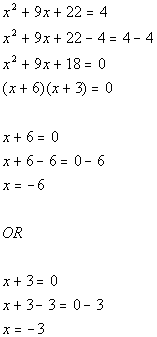 |
*Quad. eq. in standard form
*Factorthe trinomial *Use Zero-ProductPrinciple
*Set 1st factor = 0 and solve
*Set 2nd factor = 0 and solve |
| Step 4: Checkfor extraneous solutions. |
| Lets check to see if x = -6 is an extraneoussolution: |
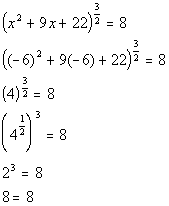 |
*Plugging in -6 for x
*True statement |
| Since we got a true statement, x = -6is a solution. |
| Lets check to see if x = -3 is an extraneoussolution: |
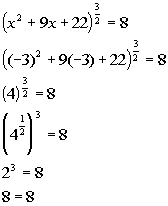 | *Plugging in -3 for x
*True statement |
| Since we got a true statement, x = -3is a solution. There are two solutions to this rational exponent equation: x= -6 and x = -3. |
All contents
July 9, 2002 |